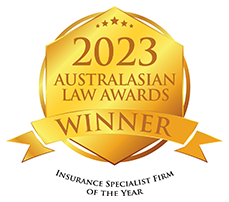Limelight Articles
Federal Court reminder on the burden of proof
The recent decision of the Federal Court of Australia in Peck v Australian Automotive Group Pty Ltd & Ateco Automotive Pty Ltd [2023] FCA 1413 provides guidance on the Court’s approach to inferential reasoning and causation, and is a reminder of the importance of preserving evidence, where possible, and ruling out alternate case theories.
Background
The applicants (Mr and Mrs Peck) brought an action for damages in the Federal Court of Australia against a supplier, Australian Automotive Group (AAG) and a motor vehicle importer, Ateco Automotive (Ateco), for loss suffered as a result of a house fire they claimed was caused by a wiring defect in a Fiat 500 motor vehicle parked in the garage of their house.
Mrs Peck owned and operated the Fiat 500 for 7 years. In that time, it was serviced regularly and she had no problems with it. On 2 March 2022, Mr and Mrs Peck woke in the middle of the night to sounds caused by a fire in their garage. Mr Peck, a retired fireman, saw flames emanating from the Fiat 500 in the garage. He attempted to extinguish the fire but was unable to do. The fire spread from the garage to the house and caused extensive damage.
Claim
The action against AAG was for breach of the consumer guarantees in sections 54(2) (Acceptable Quality) and 55(2) (Fitness for Purpose) of the Australian Consumer Law (ACL). The action against Ateco asserted a safety defect in the Fiat 500 within the meaning of Section 9 of the ACL for which Ateco would be liable as deemed manufacturer. A Cross Claim by Ateco against the Fiat Group was resolved before the trial.
The contest between the parties centred on whether there was a manufacturing defect in the Fiat 500 and if so, whether that defect caused the fire. Mr and Mrs Peck relied on evidence from a fire investigation expert (Ms Jones) and an automotive mechanic (Mr Alessi) who identified wires in the steering column of the Fiat 500 as the likely source of ignition of the fire.
Relevantly, the experts failed to properly test other possible ignition sources including the house wiring, the electrical services board and the electric roller door, and much of the critical physical evidence had not been properly preserved. Her Honour found that, due to the lapse of time and corrosion, the respondents’ expert was at a disadvantage when examining the evidence and in these circumstances, it was appropriate to “take a robust approach to fact finding”.
Decision
Inferential reasoning
Justice Cheesman rejected the applicants’ inferential reasoning, and found that their theory as to the source of the fire was but one of a number of possibilities. Her Honour quoted Dixon J in Briginshaw v Briginshaw [1938] HCA 34 who stated that, “When the law requires the proof of any fact, the tribunal must feel an actual persuasion of its occurrence or existence before it can be found. It cannot be found as a result of a mere mechanical comparison of probabilities independently of any belief in its reality”.
Justice Cheesman warned that it was not for the Court “to choose between guesses on the ground that one guess is more likely than another” and quoted Dixon J in Jones v Dunkel [1959] HCA 8, where he stated that “the facts proved must form a reasonable basis for a definite conclusion affirmatively drawn of the truth of which the tribunal of fact may be reasonably satisfied”.
Justice Cheesman found that “competing inferences of equal degrees of probability are inadequate and the choice between them must not be a mere matter of conjecture”. She agreed with Lord Macmillan in Jones v Great Western Railway (1930) TLR 39 who stated that: “The dividing line between conjecture and inference is often a very difficult one to draw. A conjecture may be plausible but is of no legal value, for its essence is that it is a mere guess. An inference in the legal sense, on the other hand is a deduction from the evidence and if it is a reasonable deduction it may have validity as legal proof. The attribution of an occurrence to a cause is always a matter of inference”.
Causation
On causation, Justice Cheesman emphasised the common-sense approach endorsed by the High Court in March v Stramare [1991] HCA 12 and Chappel v Hart [1998] HCA 55, and that causation is not to be resolved by philosophical or scientific theories. It is a question of fact to be decided by the application of common sense. Justice Cheesman also noted that whilst expert evidence may assist the Court to find causation in fact, the Court is not bound by an expert’s opinion as to the causal relationship.
Justice Cheesman was not persuaded to the requisite degree of the existence of a relevant defect. As a result, the applicants’ claim failed. In making this determination, her Honour:
- found that the case on causation ignored the sequence of events;
- criticised the applicants for failing to call an electrical wiring expert;
- highlighted the inability of the applicants’ experts to rule out other possible causes of the fire;
- found that the applicants’ experts were not properly briefed with the lay evidence.
Implications
The Peck case highlights the importance of meeting the burden of proof in product liability claims and provides a helpful explanation of the approach taken by the courts to inferential reasoning, and the common-sense approach to determine causation. The Court must feel “actual persuasion” as to the likelihood of the case theory. Competing inferences of equal degrees of probability are not sufficient to prove a fact where the choice between them is “a matter of mere conjecture”. The distinction is often a fine line and, where the proof is insufficient, may be fatal to an applicant’s case.
The judgment may also serve as a reminder for parties relying on expert evidence of the importance of calling appropriately qualified experts and ensuring that they are properly briefed so that their opinions are based on valid factual assumptions. The potential for an adverse finding against a party who fails to properly preserve critical evidence (where possible) is another lesson from this case.









